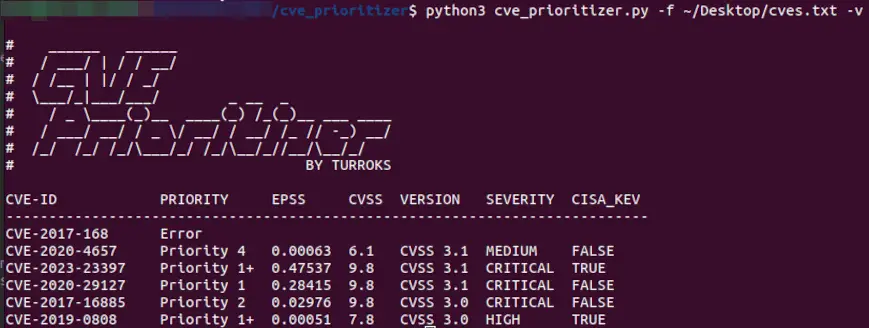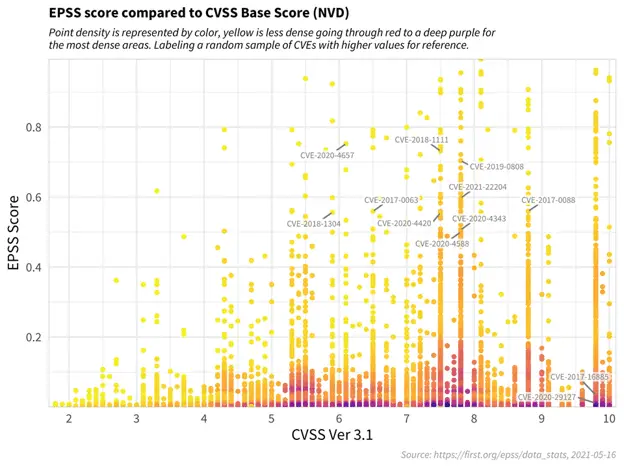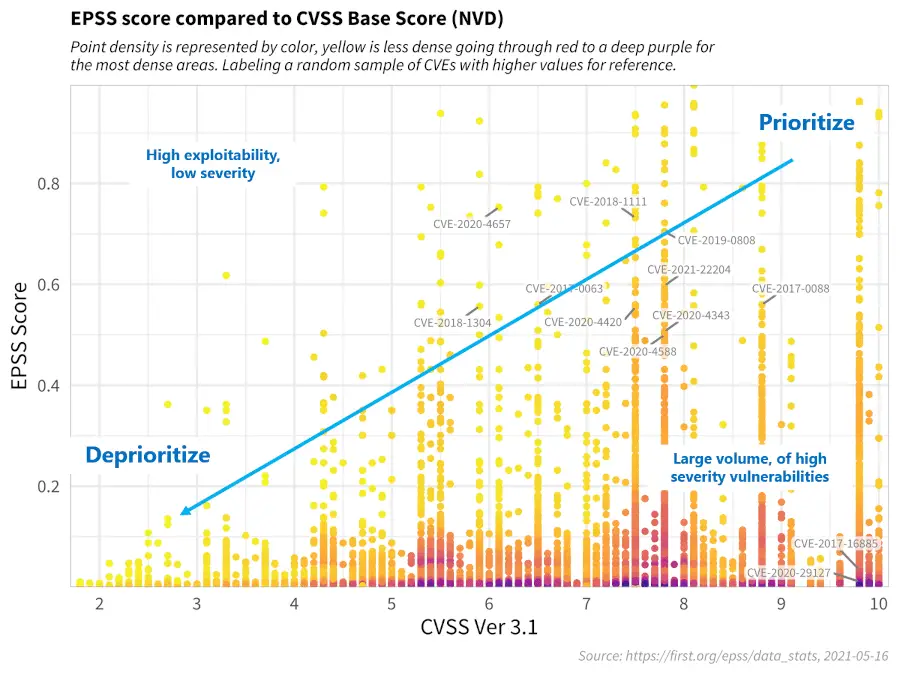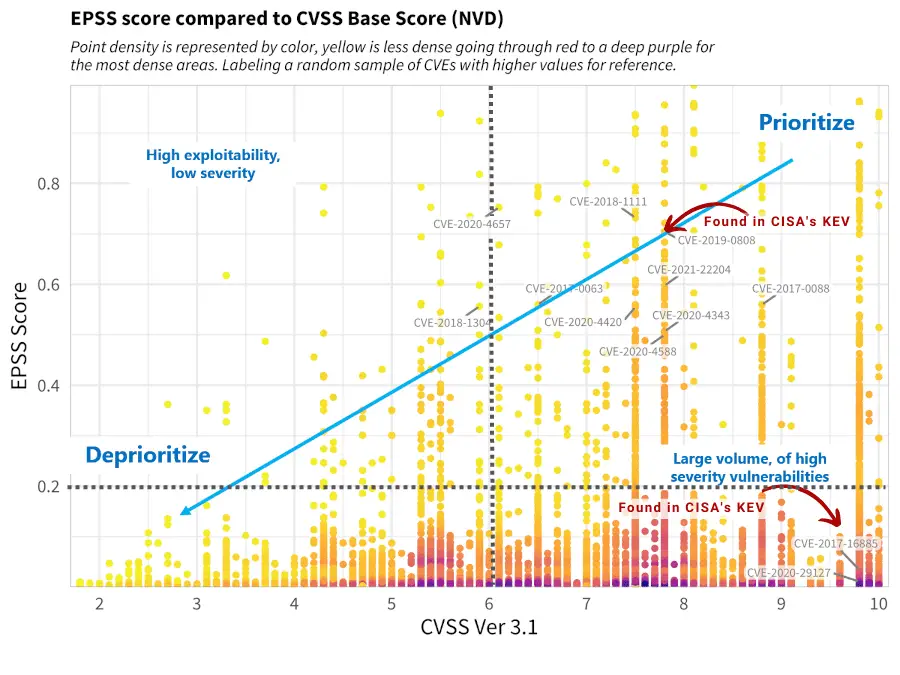CVE_Prioritizer v1.4 releases: Streamline vulnerability patching with CVSS, EPSS, and CISA’s Known Exploited Vulnerabilities

CVE Prioritizer Tool
CVE_Prioritizer is a powerful tool that helps you prioritize vulnerability patching by combining CVSS, EPSS, and CISA’s Known Exploited Vulnerabilities. It provides valuable insights into the likelihood of exploitation and the potential impact of vulnerabilities on your information system.
Why Combine CVSS, EPSS, and CISA’s KEV?
CVE_Prioritizer leverages the correlation between CVSS and EPSS scores to enhance vulnerability remediation efforts. While CVSS captures the fundamental properties of a vulnerability, EPSS offers data-driven threat information, enabling you to better prioritize patching.
Combining CVSS, EPSS, and CISA’s Kev
The team at FIRST did an amazing job explaining why one would want to combine CVSS and EPSS in their EPSS User Guide. The following material has been extracted from that document.
The figure below shows the correlation between EPSS and CVSS scores based on data from 05-16-2021. Recall that EPSS produces prediction scores between 0 and 1 (0 and 100%) where higher scores suggest a higher probability of exploitation. Each dot represents one or more vulnerabilities (CVEs). Some vulnerabilities are labeled for illustrative purposes.

First, observe how most vulnerabilities are concentrated near the bottom of the plot, and only a small percent of vulnerabilities have EPSS scores above 50% (0.5). While there is some correlation between EPSS and CVSS scores, overall, this plot provides suggestive evidence that attackers are not only targeting vulnerabilities that produce the greatest impact or are necessarily easier to exploit (such as for example, an unauthenticated remote code execution).
This is an important finding because it refutes a common assumption that attackers are only looking for (and using) the most severe vulnerabilities. And so, how then can a network defender choose among these vulnerabilities when deciding what to patch first?
CVSS is a useful tool for capturing the fundamental properties of a vulnerability, but it needs to be used in combination with data-driven threat information, like EPSS, in order to better prioritize vulnerability remediation efforts.
For the sake of discussion, consider the diagram below, which has been annotated to generally illustrate vulnerability priortitization.

- Vulnerabilities in the bottom left represent those that have both a lower probability of being exploited, and would incur a lower severity impact to the information system, and can therefore be deprioritized.
- Vulnerabilities in the upper left quadrant may be more likely to be exploited, but, on their own, would not critically impact the information system. (Further research, however, should be conducted in order to better understand how these sorts of vulnerabilities may be used in a chained attack.)
- Vulnerabilities in the bottom right represent those that, while may severely impact the information system, are much less likely to be exploited, relative to others, but should still be watched in the event that the threat landscape changes.
- Vulnerabilities in the upper right quadrant, on the other hand, are the most critical kinds of vulnerabilities which are both more likely to be exploited, and could fully compromise the information system, and should therefore be patched first.
This decision strategy as described above emphasizes the tremendous capability of EPSS. A network defender who has typically had to address thousands or tens of thousands of exposed vulnerabilities is now able to spend fewer resources, to patch more vulnerabilities that are much more likely to be exploited. This capability to differentiate among vulnerabilities has never before been possible.
Our Approach
We have refined the prioritization thresholds based on FIRST’s recommendations and our own experience. Here’s an overview:
- We include CISA’s Known Exploited Vulnerabilities, giving priority to CVEs found in KEV.
- The CVSS Threshold is set to 6.0, representing the weighted average CVSS Score from CVE Details.
- The EPSS Threshold is set to 0.2, focusing on vulnerabilities with higher relevance above this threshold.
This approach categorizes vulnerabilities into five priority levels, allowing you to allocate resources more effectively.
| Priority | Description |
|---|---|
| Priority 1+ | CVEs found in CISA’s KEV |
| Priority 1 | CVEs in the Upper Right Quadrant |
| Priority 2 | CVEs in the Lower Right Quadrant |
| Priority 3 | CVEs in the Upper Left Quadrant |
| Priority 4 | CVEs in the Lower Left Quadrant |
Below is a modified version of FIRST’s recommendation after applying our own approach.

Note: You can define your own thresholds when running the tool to tailor the results to your organization’s risk appetite.
Changelog v1.4
Enhancements
- Added Vendor and Product information to verbose mode
- Added Vendor, Product and CPE information to file
Bugs
- Added display message for CVEs not yet scored by EPSS
Install & Use
Copyright (c) 2023, Mario Rojas Chinchilla





